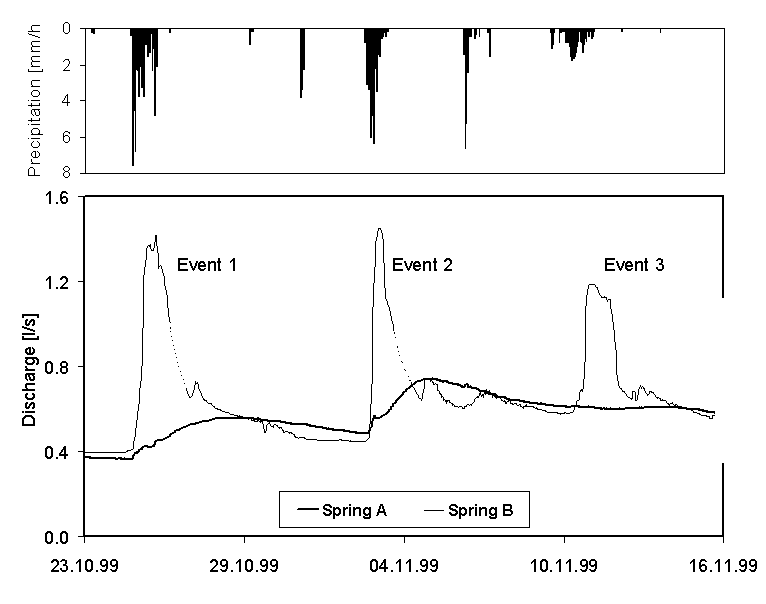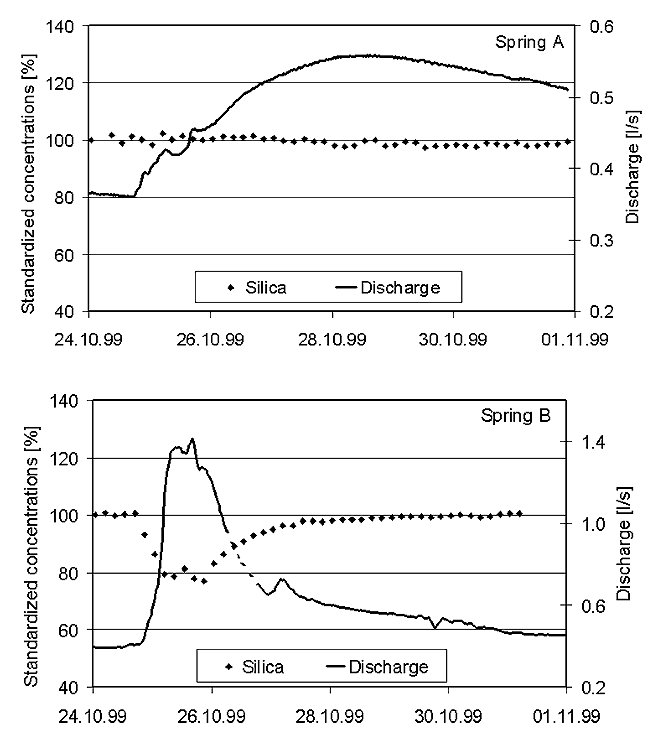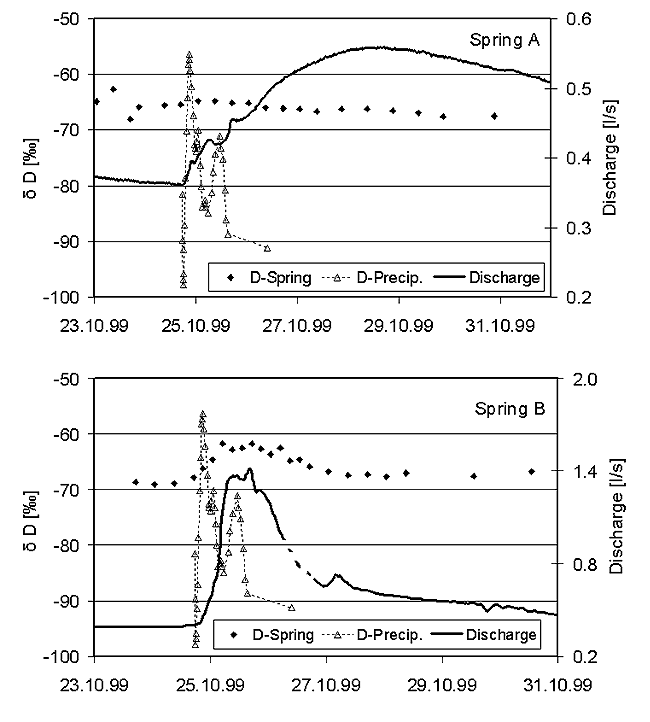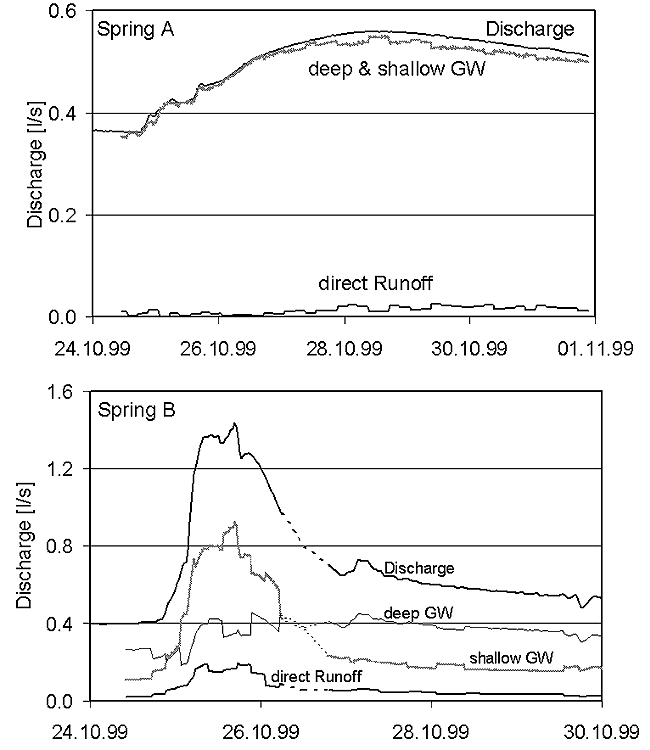|
|
 |
 |
| Subsurface flow processes at the hillslope scale |
Runoff
generation processes were investigated at several hillslopes
in mountainous catchments
in Germany and Austria. Therefore mainly tracerhydrological
investigations were carried out. The
processes and hydrological responses in mountainous
landscapes can be very diverse, even on
relatively similar hillslopes. However, the importance
of shallow soil water and groundwater systems
was demonstrated in different areas. The spatial heterogeneity
of hillslope processes is closely
related to highly variable soil structure overlain by
land use and vegetation patterns. Future changes
in hydro-climatic input (e.g. rainfall, temperature
and snow melt), or land use and vegetation cover,
will have a significant influence on the recharge of
groundwater and, consequently, on the discharge
and composition of runoff components and their hydrochemistry.
This shows the vulnerability of
groundwater, which is often used for the local water
supply in mountainous regions.
Key publications:
- Tilch N., Uhlenbrook S., Didszun J., Leibundgut
Ch., Kirnbauer R., Zillgens B., Merz B.. 2003:
Entschlüsselung von Abflussbildungsprozessen
mit Hilfe tracerhydrologischer Ansätze in einem
Wildbacheinzugsgebiet (Identification of runoff generation
processes using tracerhydrological
approaches in torrent catchment; in German). Zeitschrift
Österreichische Wasser- und
Abfallwirtschaft, Heft 1-2, 55. Jahrgang, 9-17.
- Uhlenbrook S., Didszun J., Leibundgut Ch. 2004:
Runoff Generation Processes in Mountainous
Basins and Their Susceptibility to Global Change.
In: Huber U.M., Reasoner M.A., Bugmann B.,
(Eds.), 2003: Global Change and Mountain Regions:
A State of Knowledge Overview. Advances
in Global Change Research. Kluwer Academic Publishers,
Dordrecht, in press. |
| Recent
Results of Hillslope Investigations at the Brugga Basin |
| by
Jens Didszun |
| Problem,
Objective and Method |
A long-term
hydrograph separation showed that the shallow groundwater contributes
about two-thirds
to the total runoff (Uhlenbrook et al. 2002). This highlights
the importance of this runoff component.
Two hillslopes that are drained by a spring at the toe of each
hillslope were investigated in further detail,
to extend the knowledge of runoff generation processes at the
hillslopes contributing shallow groundwater.
In mountainous areas springs at this location are often used
for local water supply because they show
a persistent discharge. The central question to be examined
in this respect is how the land use and the
structure of the periglacial debris covers influence the runoff
behaviour of the hillslopes which is observed
at the two springs. The chosen springs are more or less similar
regarding their altitude, mean discharge,
length and inclination of the hillslope. But there are differences
in the land use and the structure of the
periglacial debris cover. Although the structure of the periglacial
drift covers in the Brugga basin is
complex due to the heterogeneity of the topography and the formation
processes (Tilch et al. 2002),
four main layers reflecting the different stages and processes
of their formation can be distinguished
(REHFUESS 1990). The differences between the two hillslopes
with respect to the structure of the drift
covers are that the hillslope above spring A has no significant
coarse top layer with boulders, but at the
hillslope above spring B coarse material of the top layer is
visible at the surface. Furthermore the land
use differs, as pasture land and conifer forest is dominant
at spring A and B, respectively. |
| Results |
During
autumn 1999 the discharge during three rainfall events and
several low flow periods was monitored
continuously. Furthermore water samples were taken at each
spring with a 4-hour time interval using
automatic samplers. The water samples were analysed for stable
isotopes (18 O and 2H), dissolved silica
and major anions (Cl-, NO3-, SO42-) and cations (Na+, K+,
Ca2+, Mg2+). In addition, classical meteorological parameters
were observed at a near climate station and rainwater was
sampled every 2 mm and analysed
for stable isotopes (18 O and 2H), reported in ‰ relative
to V-SMOW.
The results show perspicuous differences between the two
springs that were more obvious than expected.
There were clear differences between the spring's hydrographs
and between the chemical and isotopic
reaction to rainfall events. Spring A is characterized by
a slow and delayed runoff behaviour (Fig. 1).
Although the time lag between rainfall and rising runoff is
only a few hours, the peak discharge is
reached not until two to four days after the beginning of
the rainfall, depending on its intensity. In
contrast to this, the time lag at spring B is shorter, the
peak discharge is higher and reached about
two days earlier, and the recession is considerably steeper
than at spring A. But despite the quick runoff
reaction of spring B it also shows a fairly constant discharge
of 0.3 l/s during summer droughts, which
suggests that the spring is fed by at least two runoff components,
a long-lasting base flow component
and a dynamic storm flow component. |
 |
Figure
1: Precipitation and discharge of both springs during autumn
1999; dotted lines represent interpolated
data due to missing data caused by technical problems. |
The
hydrochemical variations are in good agreement with the discharge
behaviour. At spring A the
concentration of dissolved silica remains fairly constant throughout
the events (Fig. 2). Only towards
the end of the recession a slight decrease of the silica concentrations
is visible. In contrast, at spring
B there is a typical decrease in the silica concentrations in
coincidence with the peak discharge.
During the investigated events the silica concentration dropped
to a minimum of about 70 % of
the pre-event concentration, but reached the pre-event concentration
again at the end of the
hydrograph recession. The concentrations of the main ions show
more or less the same type of reaction.
At spring A the concentrations stay quite constant during the
events, whereas at spring B a decrease in concentrations to
a minimum of about 50 % of the pre-event concentration was observed. |
 |
Figure
2: Dissolved Silica concentrations, set to 100 % at the beginning
of the event.
The runoff behaviour is also reflected in the isotopic compositions
of the spring waters. Spring A
shows only little and not systematic variations in the ²H
composition. At spring B is a trend towards
a ²H signature of a third component, different from the
event and pre-event signatures. This reaction
is similar during each of the three investigated events. Because
of the high d-value of ²H, it can be
assumed that this component reflects water from the debris
and drift cover, recharged several months
ago during summer times.
To quantify the contribution of the different runoff components
hydrograph separations using dissolved
silica and ²H were calculated. The theory of hydrograph
separations using natural tracers is discussed
for instance by SKLASH AND FARVOLDEN (1979) and BUTTLE (1994).
At spring A a two-component
hydrograph separation using dissolved silica was carried out
accounting for the fact that only little
variations of the hydrochemistry could be found. Assuming
that the two components are direct runoff
(rain water) and groundwater (hypothesis one), the fraction
of the direct runoff, causing the little
decrease in the silica concentration, is about 3 % during
the observed events (Fig. 4). The little direct
runoff could reach the spring within the event by flowing
along preferential pathway (i.e. root channels,
earthworm channel etc.).The rest is delivered from the shallow
and deep groundwater, however a
distinction between those two components was not possible.
A two-component hydrograph separation
can also be calculated assuming a variable contribution of
deep and shallow groundwater (hypothesis two),
with an increase of the latter during the event. However,
the silica concentrations of these two groundwater components
could not be estimated uniquely with the observed data, thus
an estimation of the fraction
of each component would be quite uncertain. Considering this
and the little variations of the silica
concentrations spring A shows only a slight change in the
fraction of the runoff components for both hypothesis. |
 |
Figure
3: ²H (D) signature of spring water and precipitation
at both springs.
At spring B a two-component hydrograph separation was not
feasible, as the ²H composition indicated
a contribution of a third component (Fig. 3). Thus a three-component
separation using silica and ²H
was calculated. The three components are direct runoff with
very little silica and the ²H composition
of the rainwater, and the shallow and the deep groundwater.
The ²H and silica concentrations for the
deep and shallow groundwater were determined using an end
member mixing analysis (EMMA) according
to CHRISTOPHERSEN et al (1990), since it was no possibility
to measure the concentrations directly.
Shallow groundwater contributes little already during base
flow prior to the events, and becomes the
major component during the peak of the event (Fig. 4). During
the three investigated events the fraction
of the direct component was about 10 % whereas the deep and
shallow groundwater made up
approximately 40 % and 50 %, respectively (Fig. 4). |
 |
Figure
4: Hydrograph separations using dissolved silica (spring A)
and using dissolved silica and ²H (spring B). |
| Discussion
and Interpretation |
These
results show that runoff generation at the catchment of the
two springs differs more clearly
than it could be assumed from the similar location of the springs
at the toe of the two steep hillslopes.
The reasons for these differences are attributed to the land
use and the structure of the debris and
drift cover at the hillslope above the springs. From the measured
data, it can not be determined absolutely
which of the reason is the most important one, but it is likely
that the root zone with many macropores
of the conifer forest together with the stony and very permeable
debris cover enables a quick delivery
of water to spring B. In contrast, the grass covered hillslope
of spring A with a slower percolation is
accounting for the delayed reaction of the hydrograph and minor
contribution of direct runoff. The fact
that a highly dynamic shallow groundwater component (including
contributions from soil water) is
dominant during events at spring B, but can not be observed
at spring A, must be caused by the
different permeability of the drift cover. However, to quantify
this effect and to identify the source
area of this component more precisely, further geophysical investigations
are needed to gain more
insight into the structure of the drift covers. In particular,
combined geophysical measurements and
tracer tests are required to understand the triggering process
responsible for dynamic contribution of
shallow groundwater in further details. |
| References
|
Buttle,
J.M. (1994): Isotope hydrograph separations and rapid delivery
of pre-event water from
drainage basins. Progr. in Phys. Geogr. 18, 1, 16-41.
Christophersen, N.C., Neal, C., Hooper, R.P., Vogt, R.D.,
Andersen, S. (1990): Modelling
Streamwater Chemistry as a Mixture of Soilwater End-Members
- A Step towards Second-Generation
Acidification Models. J. Hydrol. 116, 307-320.
Rehfuess, K.E. (1990): Waldböden - Entwicklung, Eigenschaften
und Nutzung. Pareys Studientexte, 29,
Verlag Paul Parey, Hamburg und Berlin. Sklash, M.G. and Farvolden,
R.N. (1979): The role of
groundwater in storm runoff. J. Hydrol. 43, 45-65.
Tilch N., Uhlenbrook S., Leibundgut Ch., 2002: Regionalisierungsverfahren
zur Ausweisung von
Hydrotopen in von periglazialem Hangschutt geprägten
Gebieten. Grundwasser, in press.
Uhlenbrook S, Frey M, Leibundgut Ch, Maloszewski P (2002)
Residence time based hydrograph
separations in a meso-scale mountainous basin at event and
seasonal time scales.
Wat. Resour. Res. 38, 6: 1-14. |
| back to top |
|
|







